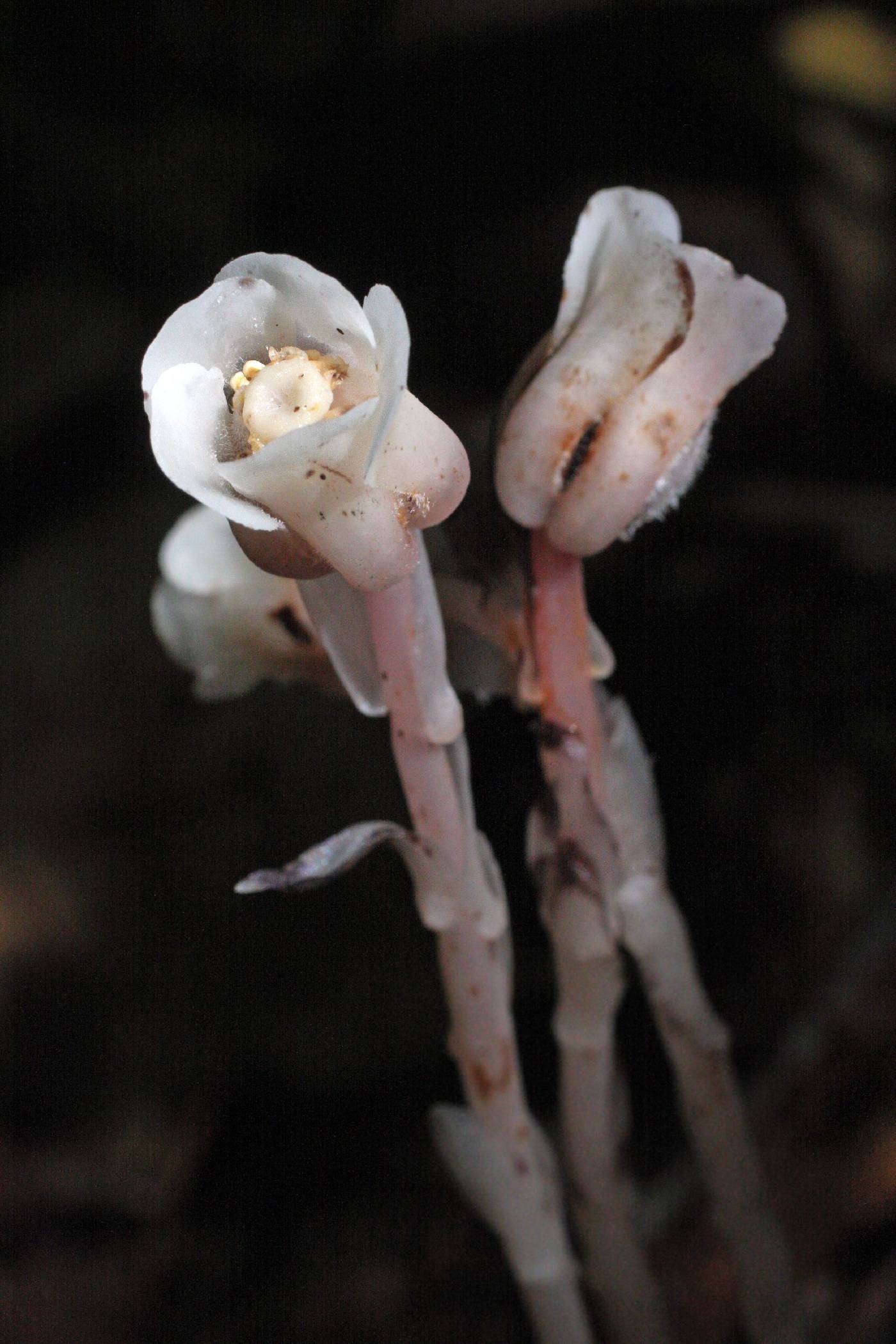Monotropa
|
Family: Ericaceae |
Herbs, achlorophyllous, heterotrophic. Stems absent. Leaves absent. Inflorescences racemes or solitary flowers, nodding at emergence from soil, becoming erect in fruit, axis fleshy and fibrous, persistent after seed dispersal, white or yellowish to orange or reddish, 0.1-1 cm diam. proximal to proximalmost flower. Pedicels nodding at anthesis, somewhat longer in fruit; bracteoles sometimes present. Flowers radially symmetric, nodding; sepals absent or (3-)4-5(-6), distinct, lanceolate, oblong, spatulate, or elliptic; petals (3-)4-5(-6), distinct, white to pinkish, reddish, yellowish, or orange, without basal tubercles, abaxial surface glabrous, adaxial surface with scattered hairs or hairy, corolla tubular-campanulate; intrastaminal nectary disc present; stamens 8-10(-14), included; filaments ± uniformly slender or slightly broader proximally than distally, glabrous or sparsely hairy; anthers transversely ellipsoid to depressed-ovoid or horseshoe-shaped, without awns, without tubules, dehiscent by 1 slit; pistil (4-)5(-6)-carpellate; ovary (4-)5(-6)-locular; placentation axile; style straight, stout or slender; stigma umbilicate to funnelform, with or without subtending ring of hairs. Fruits capsular, erect, dehiscent basipetally loculicidal, no cobwebby tissue exposed by splitting valves at dehiscence. Seeds 100+, oblong-fusiform, mostly membranously winged. x = 8. Molecular studies have demonstrated the paraphyletic nature of Monotropa and clarified relationships among some of the allied monotypic genera. A treatment realigning several genera of the achlorophyllous heterotrophs is not yet completed. Therefore, Monotropa here includes M. hypopitys and M. uniflora. Studies by K. W. Cullings (2000) and M. I. Bidartondo and T. D. Bruns (2001, 2002) suggest recognition of potential infraspecific taxa in Monotropa uniflora and M. hypopitys as well as the presence of cryptic species within M. hypopitys.
PLANT: Flowering stems 1- several, nodding, becoming erect in fruit, variously short hairy, especially in the inflorescence; bracts of various shapes, appressed, with erose margins FLOWERS: nodding, 1-several, the parts separate; sepals variable in number and shape, generally 3-5; petals 3-6, saccate at base, with hairy inner surfaces, the outer hairy or not; margins erose or ciliate; stamens 8-10(-12), in two series, alternating in length; filaments slender, hairy; anther sacs joined laterally; style short and thick to somewhat elongate; stigma umbilicate to funnelform with 4-6 shallow lobes, smooth or with a ring of hairs below; ovary (4-)5(-6)-locular, usually hairy; nectary lobes 8-10 pairs. FRUITS: erect, globose to ovoid capsules. SEEDS: minute, spindle-shaped NOTES: A N. Amer. and Eurasian genus with three species. (Greek: monos = one + tropos = direction) REFERENCES: Haber, Erich. 1992. Monotropaceae. Ariz.-Nev. Acad. Sci. 26(1)2. Pet 4-6(-8), distinct, all or some saccate at base, the cor urceolate or broadly tubular; sep 0-5; stamens 8 or 10 (-14), on slender, hairy filaments, alternately longer and shorter; anthers transverse, opening by 1 or 2 clefts across the top; ovary 4-5(6)- locular; style short, thick; stigma broad, peltate, umbilicate; capsule ovoid to subglobose, loculicidal, opening from the top downward; white, yellow, pink or red plants, turning black in drying, with erect stems beset with small scale-lvs, nodding fls the same color as the stem, and erect frs. 2, N. Hemisphere. Gleason, Henry A. & Cronquist, Arthur J. 1991. Manual of vascular plants of northeastern United States and adjacent Canada. lxxv + 910 pp. ©The New York Botanical Garden. All rights reserved. Used by permission. |

